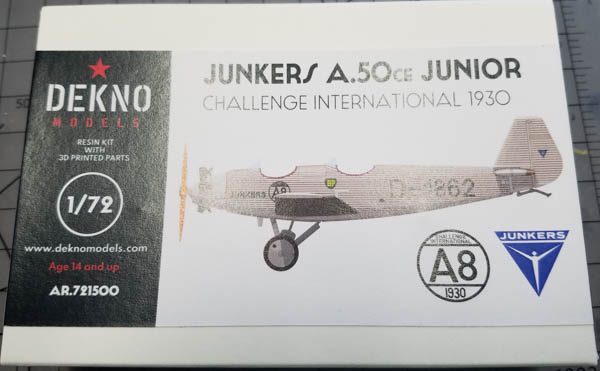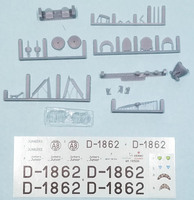
Dekno Models 1/72 Junkers A.50 ce Junior - International Challenge de Tourisme 1930
By Matt Bittner
Overview
The Junkers A.50 Junior was originally designed as a light, private aircraft that was produced in a few versions, mainly differing in engine-types, with around 85 produced. It participated in a number of races and challenges, and even saw limited military use. There is one, original Junior in existence in Finland. The best reference on the type is the book put out by European Airlines, Elegance and Versatility.
In an odd twist of fate, Junkers has brought back the basic Junior design and is now producing a more "modern" version of the aircraft, but with the overall look-and-feel of the original still in its "bones".
The Kit
The Dekno Models 1/72 Junkers A.50 Junior consists of 7 pieces of "standard" resin, 29 pieces of 3D printed parts, and four vac-formed windscreens. Decals are just for the single Junior that participated in the International Challenge de Tourisme, 1930; the decals are nicely printed and appear to be in register.
The resin parts are top-notch and the 3D printed parts are beyond compare. The engine cylinders need to be seen to be believed; they are works of art.

|
Construction naturally starts with the cockpit which consists of the floor, two bulkheads, two instrument panels, two seats and two control sticks; decals exist for the instrument panels. Since these are very open cockpits, you may want to add more, although pictures of the interior are definitely lacking. Once the cockpit is assembled and painted, it's glued into one fuselage half and the halves glued together. Also added at this time is the single nose-piece. Mine has "print lines"/striations on it so will need to be sanded.
Now you make the model look like an aircraft, by gluing the wings to the fuselage followed by the tail parts. The next instruction step has you glue the landing gear on, which I would recommend since it will provide strength and the model was "natural metal" throughout.

|
The last steps of the instructions are mostly best left until after the model is painted, except for two areas: adding the tail struts and aileron control horns. Those I plan on adding before painting since the model is a single-color (minus the natural metal, non-corrugated nose). But the rest are definitely best left until last: adding the engine cylinders, prop, windscreens and venturi tube.
Conclusion
Dekno Models had produced a very nice kit of the Junkers A.50 ce Junior. Once assembled it will be a unique addition to your modeling shelves. Note that Dekno has released - and will release - other versions of the Junior, currently the other being one flown by Bolivia during the Chaco War. Also note that Arctic Decals (the maker of the Junior's decals) is also planning on a couple of other Junior releases, including one on floats and a Finnish example on skis. Looks like there may be more Junior kits in my future.
Huge, HUGE thanks to Dekno Models for the review kit.
